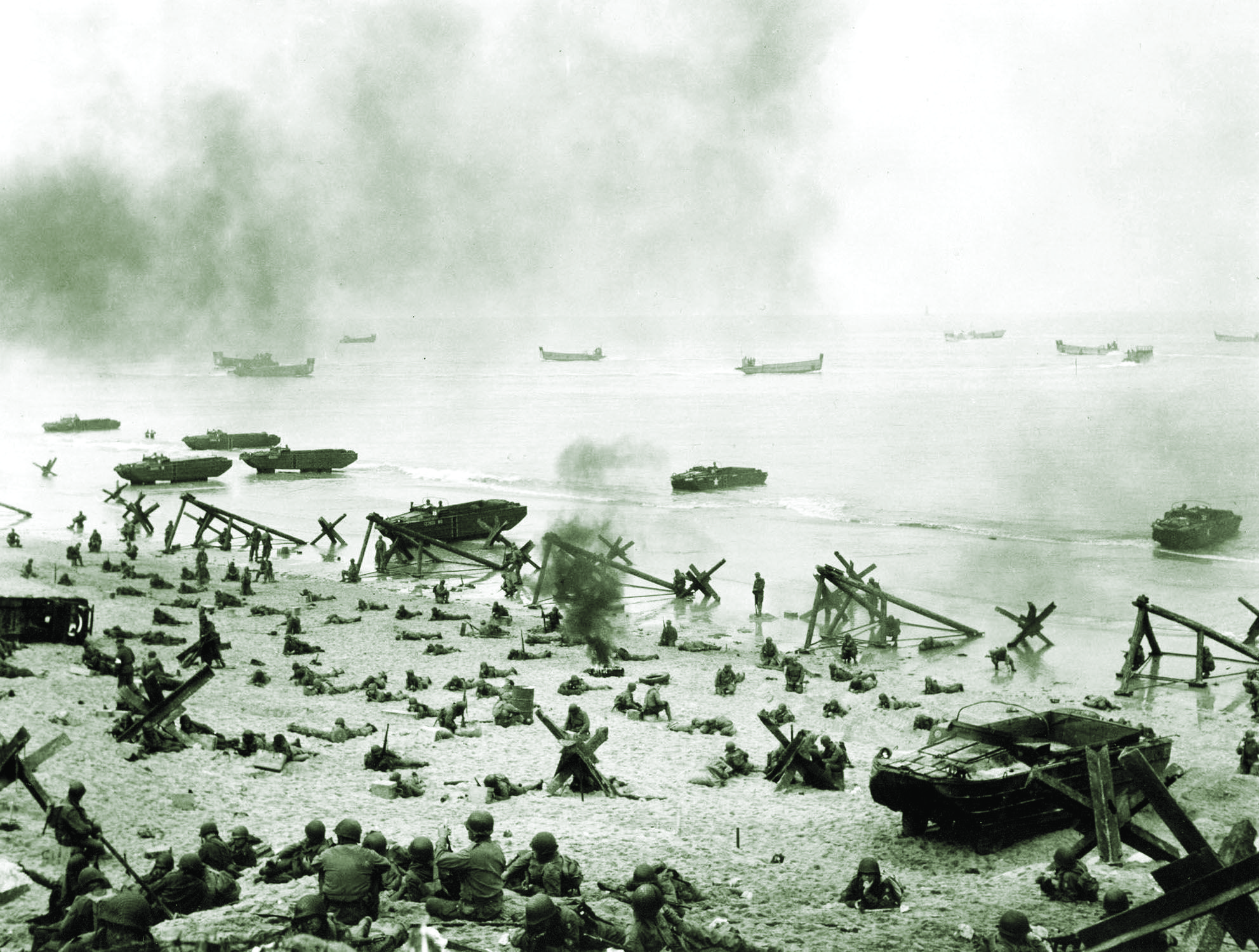Producer Darryl F. Zanuck received assistance from several NATO countries to help recreate D-Day in his epic 1962 film, The Longest Day.
In 1963, MAD magazine informed its readers that traditional military service songs were hopelessly outmoded. A case in point was “The Army Goes Rolling Along,” the official song of the U.S. Army. “In the age of military mobility,” the writers asked, “how many artillerymen march over hill and dale…or anywhere else?” And when was the last time grizzled dogfaces let loose with anything as boyish as “Hi-hi-hee”? Far more in tune with the times, they declared, was “The Cameras Go Rolling Along,” with lyrics reinvented to commemorate the myriad service personnel routinely being used as movie extras: “Hit the beach, kill a Hun / With those blanks there in your gun!”
The writers had a point. The armed forces and the film industry had a symbiotic relationship that preceded even World War I. “Hollywood,” writes film historian Lawrence H. Suid, “has always believed that for military movies to succeed…they must have an authentic ambience”—which the armed forces can provide through technical assistance, men, and hardware. Meanwhile, Suid points out, the military “has seen these films as a superb public relations medium” and given lavish assistance, provided the results portrayed the armed forces in a flattering light. The Longest Day (1962), a sprawling recreation of the 1944 Normandy invasion, is one of the most striking examples of this dynamic in cinema history.
The driving force behind the production was Hollywood mogul Darryl F. Zanuck. Perhaps no filmmaker has ever shown greater prowess in gaining the armed forces’ cooperation. (He was so well-known for this talent that MAD’s satirical lyrics even mention him by name.) Zanuck was a legendary producer of dozens of films, including The Grapes of Wrath (1940) and All About Eve (1950), but his magnum opus is The Longest Day.
The film was based on the 1959 bestselling book by Irish journalist Cornelius Ryan; he had covered the original D-Day landings and then spent a decade interviewing over a thousand participants, ranging from privates to field marshals, fighter pilots to sailors, British commandos to French Resistance fighters. The resulting work was epic in scale.
Mesmerized by the dream of transferring that epic to celluloid, Zanuck paid $175,000 for the film rights and touted the project as “the most ambitious undertaking” since 1939’s Gone with the Wind. He enlisted Ryan to write the screenplay, with support from several other screenwriters; recruited a huge international cast featuring dozens of famous actors; hired three directors and four cinematographers; and spent $10 million—in those days, an astonishing sum.
For military assistance, Zanuck approached the armed forces of the major countries involved in the invasion: the United States, West Germany, France, and Great Britain. They responded with gusto; as members of the North Atlantic Treaty Organization (NATO), the subtext for their participation was a shared commitment to containing aggression by the Soviet Union.
The United States allocated about 2,000 army troops and Marines to the production. Germany contributed no troops: seeking to distance itself from the Nazi years, the Bundeswehr had already discarded its World War II uniforms anyway. But it did furnish considerable technical aid—and in return, German troops received a flattering portrayal as apolitical, gallant, and professional. France, for its part, was lavish in its provision of troops. Charles de Gaulle’s government saw the production as a way to emphasize France’s contribution to the Allied victory and thereby mute the four-year period in which France had collaborated with its Nazi occupiers. Notwithstanding the fact that France was then involved in a major war in Algeria, the nation lent Zanuck some 3,000 soldiers, who at one point even donned U.S. uniforms to make up for a shortfall in American infantry. The British also contributed men, weapons, landing craft, and technical expertise, although they balked at using the Royal Navy to recreate the landings on the Normandy beaches unless Zanuck paid the estimated $300,000 in fuel oil costs. Instead, Zanuck filmed the landing sequences on Corsica, taking advantage of training exercises being conducted in the area by the U.S. Sixth Fleet.
The NATO forces received a considerable return on their investment. Throughout the production, Zanuck insisted that The Longest Day was really about the preservation of “our way of life” and “a reminder to millions and millions of people that the Allies, who once stood together and defeated an evil because they stood together, can do so again in a different situation today which in some ways is similar to what they faced in 1940.” It was, in effect, a statement of the tacit bargain he had made with the respective militaries who supported the production. Viewers who watch The Longest Day are not just seeing an epic about World War II. They are also witnessing a dramatic artifact of the Cold War.
This article was published in the February 2020 issue of World War II.





